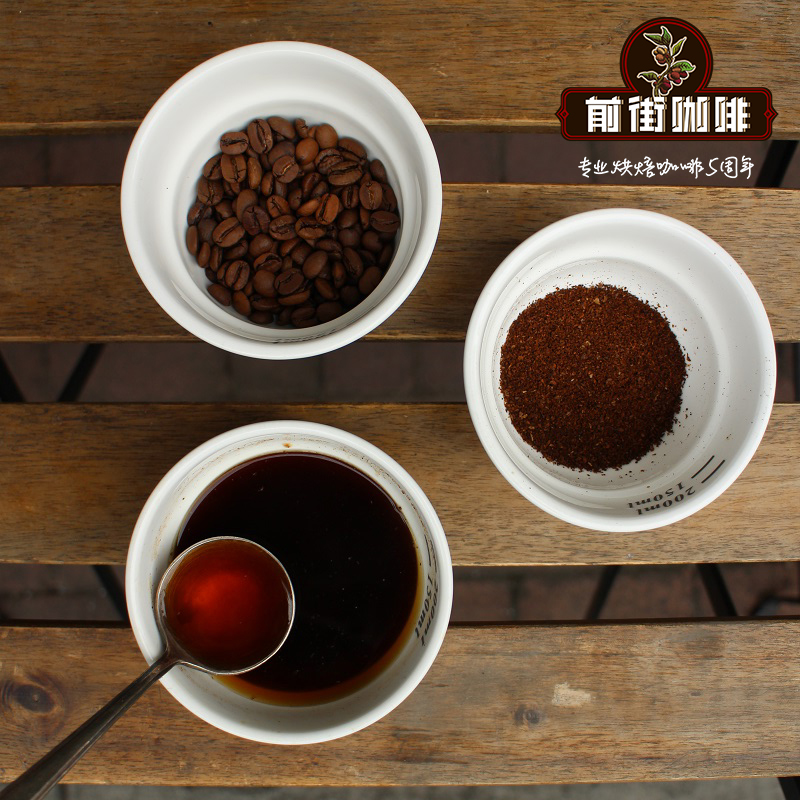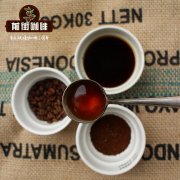What does the hand selection in Coffee mean? the reason for Indonesia Manning's three hand selections

Professional coffee knowledge exchange more coffee bean information please follow the coffee workshop (Wechat official account cafe_style)
Raw bean
In the industry, people often say that raw beans refer to "the core of coffee fruit, the core in the core (usually with left and right lobes)."
After treatment (sun / water washing / semi-washing, etc.), the fruit fermentation process, dry coffee beans with a water content of 10-12%.
As pictured above, most of the raw beans processed in the manor are dried from the germ core to the pectin layer, or from the germ heart to the sheep skin. What is sold to the baker is usually the part from the germ core to the silver skin, known as the "raw bean".
The taste of fruit does not vary from size to size. What about coffee beans? What happens if coffee beans harvested from the same tree, regardless of grain size, ripe or immature, are all baked in the same pot?
Raw beans before selection
When thick beans are baked with thin beans, the heat permeability of beans with thick beans is poor, and the central part (the part of the bean that has not been removed) will be in a "cored" state that cannot be baked. Cut open, the beans are divided into baked and unbaked parts. The coffee liquid extracted from the cored coffee will have a strong smell of choking throat.
To get back to the point, when choosing raw coffee beans, beans with uniform shape, thickness, size, color, central line and so on are all the best. In short, average beans are good beans. Unfortunately, such beans are extremely rare.
How to measure the standard?
Some people may ask, what do you mean by G1 and G2, what do you mean by AA and AB, and why some G2 tastes better than G1? These are grading methods, and they are official ones, depending on size, defect rate and altitude.
1. Strictly speaking, large granule coffee beans have better flavor. In fact, the beans collected from the same coffee tree are baked and extracted, and the taste can be obviously compared after the cup test. Beans with large grains and smooth growth taste better.
2. It is better to have the same color of beans. The colors of raw beans are cyan, brown and other colors, and the color of beans represents water content, so it is easier to bake beans with the same color. Generally speaking, cyan and green indicate more moisture, while brown almost white represents less moisture.
3. For the shape of beans, it is better to have thick meat. The flavor is rich and deep, generally speaking, only the fleshy coffee beans produced in the highlands.
4. The central line (the longitudinal rill in the center of the coffee bean). Beans with a clear and clear central line are of high quality. In addition, the silver skin covered on its surface is literally silver. Most of the tea-brown ones with silver skin are defective, except for the well-managed natural drying beans.
Hand selection
Hand selection is the step of removing impurities and bad beans attached to delicious coffee beans. Coffee beans are often mixed with foreign bodies, such as stones, sawdust, pieces of metal, grains of soil, fruit of trees, and sometimes coins and glass.
Hand-selected reasons
In coffee production areas, specific gravity bean selector (using wind power to classify according to particle size and weight) or electronic bean selector (removing defective beans according to color) will be used to prevent impurities and defective beans from mixing, but it is only natural that they cannot be prevented. It still has to be chosen by human hands.
In particular, unripe beans are difficult to remove by machine and must be removed by hand. And these unripe beans will have a very bad effect on the taste of coffee. Defective beans in addition to unripe beans, there are dead beans, worm-eaten beans, black beans, moldy beans, shell beans, fermented beans, broken beans, shell beans, cocoa and so on.
Common coffee defective beans
Here are the common coffee leftover beans, or when graded as bad points:
Moldy bean
Moldy beans: because of incomplete drying, or damp in the process of transportation and storage, cyan and white molds grow, which sometimes make the beans stick together. If these moldy beans are not removed, they will produce moldy smell.
Dead bean
Dead beans: beans with abnormal results. The color is not easy to change because of baking, so it is easy to distinguish. The flavor is thin, as harmful as silver skin, and will become a source of peculiar smell.
Immature bean
Immature beans: beans picked before they are ripe have a fishy, disgusting taste. Leaving raw coffee beans for years is a strategy to deal with these immature beans.
Moth-eaten bean
Moth-eaten beans: moths invade and lay eggs when the coffee fruit is ripe and red, and the larvae eat the coffee fruit and grow, leaving traces of moth on the surface of the beans. Worm-eaten beans can cause the coffee liquid to be cloudy and sometimes produce a strange smell.
Shell bean
Shell beans: produced by poor dryness or abnormal mating; the beans break from the central line and the inside is turned out like a shell. Shell beans can cause uneven baking and are easy to catch fire during deep baking.
Black bean
Black beans: beans that mature early and fall to the ground and ferment and blacken when they come into contact with the ground for a long time. It can be easily removed by hand-selected steps. Coffee mixed with black beans will smell rotten and cloudy.
Dried beans (cocoa)
Over-dried beans (cocoa): it is caused by natural drying that the pulp remains and is not fully shelled. With iodine flavor, soil flavor and other flavor, it will give off a bad smell.
Shelled bean
Shell beans: endocarp covers the inside of the pulp of coffee beans and remains on the washed coffee beans. The poor heat permeability when roasting and sometimes burning is the reason for the astringent taste of coffee.
Stones mixed with coffee beans
Stone: beans harvested are easily mixed with stone or sawdust because of natural drying.
Hand-selected sequence
Hand selection is carried out once in the raw bean stage, and again after baking, which means once before and after baking. The proportion of defective beans is surprisingly high, leaving only about 60% to 70% of coffee beans available after baking. To reduce the roasting failure rate, you must buy high-precision and high-quality coffee beans as much as possible; if you are still afraid of roasting failure, the steps to remove defective beans should not be lazy. Defective beans are fatal to the taste of coffee.
When the ripe and red coffee fruit is picked by hand, the mixing rate of defective beans should be much lower, but in fact it will be picked along with the green and immature fruit during the harvest. Sometimes, even the branches are broken down in pursuit of harvest efficiency. The water-washed coffee because the refining process must be washed many times, so it is more difficult to mix with stones, glass sheets and other impurities, but if the non-washing natural drying coffee, the degree of impurity mixing is quite high.
The quickest way to understand the importance of hand-selected steps is to test the coffee liquid extracted by roasting only defective beans. After drinking it, you will find that your tongue will remain paralyzed for hours. It can be proved that hand selection is an indispensable and important step in making delicious coffee.
Hand-selected sequence
1. Take the right amount of raw beans and put them in the tray
2. Select raw beans until they are flawless.
3. Don't just stare at one side of the bean, but pick it up to see its color and shape. Don't miss any one, move your eyes from the right to the left.
4. Repeat the same steps again and again
5. Know the average value of picking out defective beans.
Manning Coffee
Manning coffee is one of the most famous coffee in Indonesia. What makes it special is that it has a special flavor. Some people say it is like a cigar, some say it is like spice, some say it is a straw mat. In short, it is a very unique taste, which many people will like as soon as they drink it.
Most of these flavors come from his traditional processing technology. In Indonesia, there is a process called wet planing, which takes out the coffee beans before the pectin fruit is dried. At this time, the humidity of coffee beans is about 30%, 40%, which is very soft, so there will be some scratches on the surface. These scratches will produce slight fermentation later in the sun, which reinforces the flavor.
Generally speaking, Manning coffee is characterized by rich fragrance and full of vicissitudes. The great flood and leaf ball disease did not beat it, but it has lasted to this day. It can still show its unusual flavor to the world, almost reminiscent of the earthy smell of Sumatra as far away as the 19th century.
END
Important Notice :
前街咖啡 FrontStreet Coffee has moved to new addredd:
FrontStreet Coffee Address: 315,Donghua East Road,GuangZhou
Tel:020 38364473
- Prev

Introduction of the origin and planting conditions of Richter Manor in Costa Rica
ElBalar is a 5-hectare farm where Kaddura is grown. It is owned by the father of three siblings: Leo,Melvin and ElianRobles, who worked on the farm with their father for many years. ElBalar is located about 1500 meters above sea level in San Marco de Tarazu. The farm has rich sandy soil and can be planted with high quality.
- Next

Salvador honey treated Wulashan manor Bourbon species High altitude SHB grade
Professional coffee knowledge exchange More coffee bean information Please pay attention to coffee workshop (Weixin Official Accounts cafe_style) El Salvador is mainly divided into five main producing areas, namely Apaneca, Central Belt, Chichontepec, Tecapa Cacahuatique Mountain Range, which are roughly distributed on volcanic ash covered mountain slopes or plateaus above 1,200 meters above sea level.
Related
- Detailed explanation of Jadeite planting Land in Panamanian Jadeite Manor introduction to the grading system of Jadeite competitive bidding, Red bid, Green bid and Rose Summer
- Story of Coffee planting in Brenka region of Costa Rica Stonehenge Manor anaerobic heavy honey treatment of flavor mouth
- What's on the barrel of Blue Mountain Coffee beans?
- Can American coffee also pull flowers? How to use hot American style to pull out a good-looking pattern?
- Can you make a cold extract with coffee beans? What is the right proportion for cold-extracted coffee formula?
- Indonesian PWN Gold Mandrine Coffee Origin Features Flavor How to Chong? Mandolin coffee is American.
- A brief introduction to the flavor characteristics of Brazilian yellow bourbon coffee beans
- What is the effect of different water quality on the flavor of cold-extracted coffee? What kind of water is best for brewing coffee?
- Why do you think of Rose Summer whenever you mention Panamanian coffee?
- Introduction to the characteristics of authentic blue mountain coffee bean producing areas? What is the CIB Coffee Authority in Jamaica?

